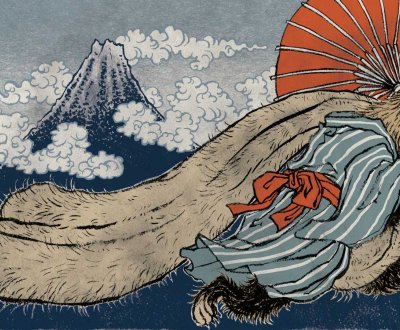Sacred and Legendary Japanese Animals
A lot of animals have earned their status of sacred entities, thanks to a sometimes literal interpretation of legends, and to the background of Shinto philosophy into which each thing has its own life and will.
Nearly 65% of the Japanese territory is in fact uninhabited and occasionally wild, so the country’s wildlife is naturally abundant while sharing territories with the human population. A well-known example are Nara’s deer. Called shika in Japanese, they roam freely in the city’s park and its surroundings, and have the particularity to keep a spotted coat when adult, like bucks. Beside Nara and Miyajima, the species mainly lives in Hokkaido. These animals came to be considered sacred thanks to the legend of Takemikazuchi (建御雷), the god of thunder worshiped at Kasuga Taisha shrine, who is said to have descended on the city riding a deer.
Other animals live both in the archipelago’s folklore and daily life.
Tanuki
Also called "Japanese racoon dog", the tanuki 狸 is a canid living with its mate and offspring. It looks like a big racoon that hibernates in winter when temperatures are very low. It is an omnivorous, eating mainly small animals and a few plants. It is sought after for its thick fur and according to the statistics constitute more than 10% of the animals killed by hunting in Japan.
In the Japanese folklore, it is a yokai (a spirit) called "bake danuki". Its mythological aspect is different from the actual animal that can be encountered in the Japanese countryside: standing on its hind legs, wearing a sugegasa conical straw hat, with a bulging belly and oversize testicles. It has often been pictured in the Japanese art since the Middle Ages and has been labeled a mischievous spirit in the same line as the fox in Europe.
The tanuki is therefore a protagonist of many Japanese legends, tales and farces, the most renown being the story of the monk and the kettle, and they star in the animated movie Pompoko by Isao Takahata. It is able to shape shift and play tricks on the humans. Nevertheless, its statues ornament the gardens of houses or restaurants to attract good fortune.
Crane
The crane (鶴 tsuru) is the tallest bird of Japan, and can measure up to 1,5 meters tall, it is smaller than an ostrich but taller than a flamingo. It is easily identifiable thanks to the red part on the top of its head when adult (which earned it the nickname of "red-crowned crane") and the black ends of its plumage that is otherwise an immaculate white. The species exits in other parts of the world but the Japanese one is found in Hokkaido, and it does not migrate from this island. Cranes live near rivers and eat grains, plants, and small animals.
Nowadays it is an endangered species, but its population could grow thanks to the help of Human nourishing it in winter. The Japanese crane is at the center of the legend of the 1,000 cranes: if one folds 1,000 origami paper cranes, the sick person to whom it is intended will recover. The crane is indeed a symbol of longevity and of immortality in Taoism: the Japanese think it can live more than 1,000 years.
Japanese macaque
The Japanese macaque (ニホンザル Nihon zaru) can be found throughout the archipelago except in Hokkaido. This monkey 🐒 has a fluffy coat, and its face and bottom become red during the mating season. It is less than one meter tall and can live up to 20 years old. They are seldom encountered in the city, as their natural habitat is the Japanese mountains. It is the only monkey species to live in Japan.
In winter, the macaques are looking for heat by immersing in the natural onsen ♨️ hot springs (the most famous spot being Jigokudani in Nagano). To explain the phenomenon, a legend tells that in a past time's harsh winter, the macaques were on the brink of death due to the cold. The samurai that were taking care of them solicited snowy owls 🦉 to help them find a solution. The birds flew to the sun and took a piece of it in their beak. Then they dropped the sun pieces on the snow, that started to melt and created a hot spring 🌸 into which the macaques were immersed to help them warm up.
The Japanese macaque is the monkey pictured in the Asian symbol of Three Wise Monkeys:
- The first, Mizaru, is hiding its eyes;
- The second, Kikazaru, is hiding its ears, and,
- The third, Iwazaru hides its mouth.
Together, they picture the proverb: "see no evil, hear no evil, speak no evil".
---
During your trip in Japan, don’t hesitate to travel away from the urban centers to get the chance to encounter these animals, as well as other, maybe not sacred but that are also part of the archipelago’s biodiversity.



